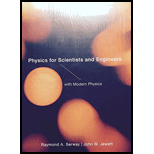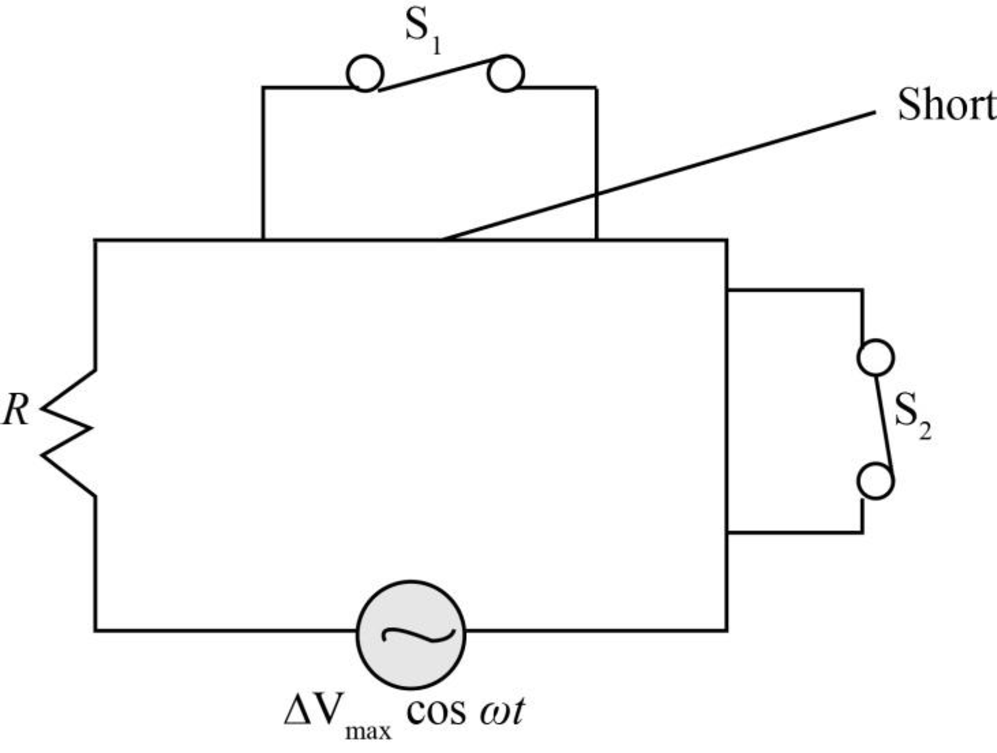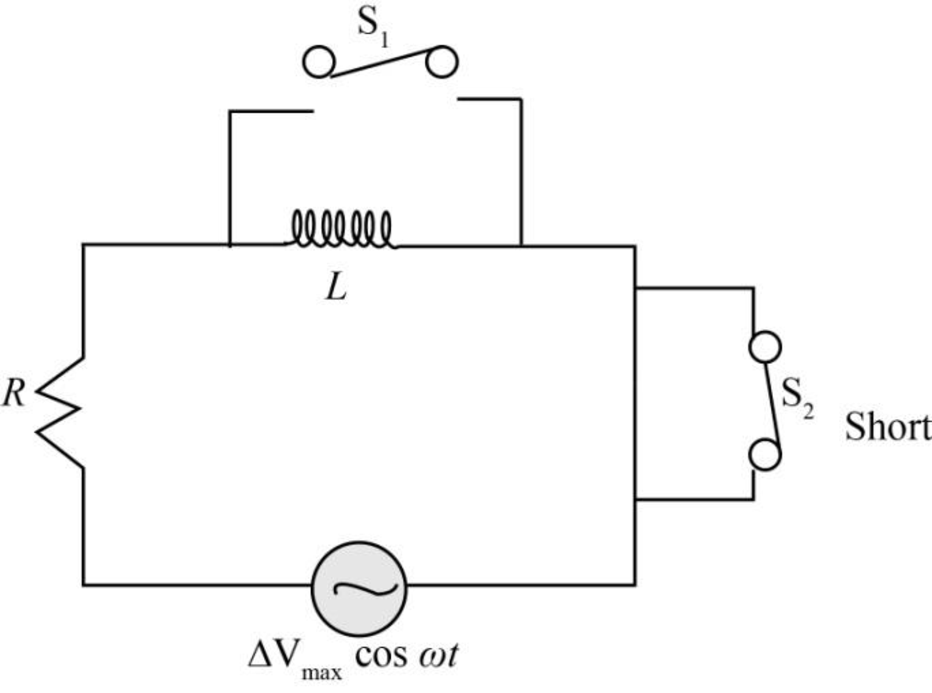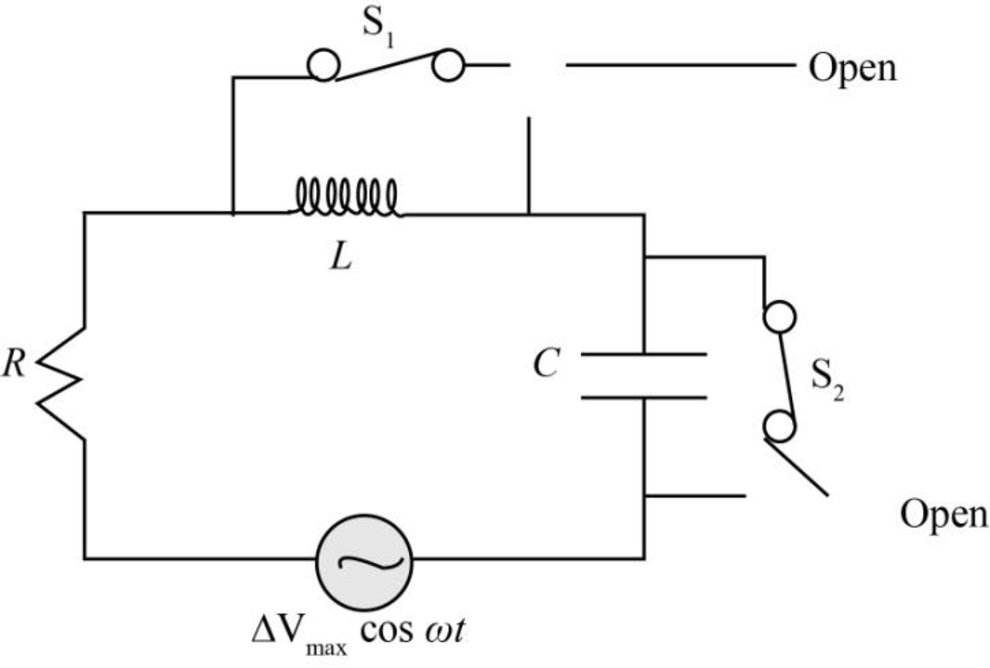
(a)
The current in the circuit as a function of time.
(a)
Answer to Problem 72AP
The current in the circuit as a function of time is
Explanation of Solution
The circuit in which capacitor and inductor are short circuited and both the switch are closed is as shown below.

Figure-(1)
Write the expression to obtain the time varying voltage source.
Here,
Write the expression to obtain the current in the circuit as a function of time.
Here,
Substitute
Conclusion:
Therefore, the current in the circuit as a function of time is
(b)
The power delivered to the circuit.
(b)
Answer to Problem 72AP
The power delivered to the circuit is
Explanation of Solution
Write the expression to obtain the power delivered to the circuit.
Here,
Substitute
Conclusion:
Therefore, the power delivered to the circuit is
(c)
The current in the circuit as function of time if only switch
(c)
Answer to Problem 72AP
The current in the circuit as function of time if only switch
Explanation of Solution
The circuit in which switch

Figure-(2)
In case of inductor circuit, the phase difference between the current and voltage is
Write the expression to obtain the time varying voltage source in case
Here,
Write the expression to obtain the impedance in the circuit.
Here,
Write the expression to obtain the current in the circuit as a function of time.
Here,
Substitute
Conclusion:
Therefore, the current in the circuit as function of time if only switch
(d)
The capacitance of the capacitor when both the switches are closed and the current and voltage are in phase.
(d)
Answer to Problem 72AP
The capacitance of the capacitor when both the switches are open and the current and voltage are in phase is
Explanation of Solution
The circuit in which both the switches are open as shown in the figure below.

Figure-(3)
Write the expression obtain the impendence of the inductor.
Here,
Write the expression obtain the impendence of the capacitor.
Here,
When the current and voltage in the circuit are in phase, than the impendence of the inductor and the capacitor are equal.
Write the expression to obtain the relation the capacitance of the capacitor.
Here,
Substitute
Conclusion:
Therefore, the capacitance of the capacitor when both the switches are open and the current and voltage are in phase is
(e)
The impendence of the circuit when both the switches are open.
(e)
Answer to Problem 72AP
The impendence of the circuit when both the switches are open is
Explanation of Solution
Write the expression when both the switches are open.
Here,
Write the expression to obtain the impendence of the circuit.
Here,
Substitute
Conclusion:
Therefore, the impendence of the circuit when both the switches are open is
(f)
The maximum energy stored in the capacitor during the oscillations.
(f)
Answer to Problem 72AP
The maximum energy stored in the capacitor during the oscillations is
Explanation of Solution
Write the expression to obtain the voltage across the capacitor.
Here,
Substitute
Write the expression to obtain the maximum energy stored in the capacitor.
Here,
Substitute
Conclusion:
Therefore, the maximum energy stored in the capacitor during the oscillations is
(g)
The maximum energy stored in the inductor during the oscillations.
(g)
Answer to Problem 72AP
The maximum energy stored in the inductor during the oscillations is
Explanation of Solution
Write the expression to obtain the maximum energy stored in the inductor.
Here,
Substitute
Conclusion:
Therefore, the maximum energy stored in the inductor during the oscillations is
(h)
The phase difference between the current and the voltage when frequency of the voltage source is doubled.
(h)
Answer to Problem 72AP
The phase difference between the current and the voltage when frequency of the voltage source is doubled is
Explanation of Solution
Write the expression to obtain the phase difference between the current and voltage.
Here,
Substitute
As the frequency of the voltage source is doubled.
Substitute
Conclusion:
Therefore, the phase difference between the current and the voltage when frequency of the voltage source is doubled is
(i)
The frequency that makes the inductance reactance one-half the capacitive reactance.
(i)
Answer to Problem 72AP
The frequency that makes the inductance reactance one-half the capacitive reactance is
Explanation of Solution
Write the expression to obtain the frequency that makes the inductance reactance one-half the capacitive reactance.
Here,
Substitute
Conclusion:
Therefore, the frequency that makes the inductance reactance one-half the capacitive reactance is
Want to see more full solutions like this?
Chapter 33 Solutions
Physics For Scientists And Engineers With Modern Physics, 9th Edition, The Ohio State University
- No chatgpt plsarrow_forwardhelp me with the experimental set up for the excel i did. the grapharrow_forwardWhich of the following best describes how to calculate the average acceleration of any object? Average acceleration is always halfway between the initial acceleration of an object and its final acceleration. Average acceleration is always equal to the change in velocity of an object divided by the time interval. Average acceleration is always equal to the displacement of an object divided by the time interval. Average acceleration is always equal to the change in speed of an object divided by the time interval.arrow_forward
- The figure shows the velocity versus time graph for a car driving on a straight road. Which of the following best describes the acceleration of the car? v (m/s) t(s) The acceleration of the car is negative and decreasing. The acceleration of the car is constant. The acceleration of the car is positive and increasing. The acceleration of the car is positive and decreasing. The acceleration of the car is negative and increasing.arrow_forwardWhich figure could represent the velocity versus time graph of a motorcycle whose speed is increasing? v (m/s) v (m/s) t(s) t(s)arrow_forwardUnlike speed, velocity is a the statement? Poisition. Direction. Vector. Scalar. quantity. Which one of the following completesarrow_forward
- No chatgpt pls will upvote Already got wrong chatgpt answerarrow_forward3.63 • Leaping the River II. A physics professor did daredevil stunts in his spare time. His last stunt was an attempt to jump across a river on a motorcycle (Fig. P3.63). The takeoff ramp was inclined at 53.0°, the river was 40.0 m wide, and the far bank was 15.0 m lower than the top of the ramp. The river itself was 100 m below the ramp. Ignore air resistance. (a) What should his speed have been at the top of the ramp to have just made it to the edge of the far bank? (b) If his speed was only half the value found in part (a), where did he land? Figure P3.63 53.0° 100 m 40.0 m→ 15.0 marrow_forwardPlease solve and answer the question correctly please. Thank you!!arrow_forward
 Physics for Scientists and Engineers, Technology ...PhysicsISBN:9781305116399Author:Raymond A. Serway, John W. JewettPublisher:Cengage Learning
Physics for Scientists and Engineers, Technology ...PhysicsISBN:9781305116399Author:Raymond A. Serway, John W. JewettPublisher:Cengage Learning Principles of Physics: A Calculus-Based TextPhysicsISBN:9781133104261Author:Raymond A. Serway, John W. JewettPublisher:Cengage Learning
Principles of Physics: A Calculus-Based TextPhysicsISBN:9781133104261Author:Raymond A. Serway, John W. JewettPublisher:Cengage Learning
 Physics for Scientists and Engineers: Foundations...PhysicsISBN:9781133939146Author:Katz, Debora M.Publisher:Cengage Learning
Physics for Scientists and Engineers: Foundations...PhysicsISBN:9781133939146Author:Katz, Debora M.Publisher:Cengage Learning College PhysicsPhysicsISBN:9781305952300Author:Raymond A. Serway, Chris VuillePublisher:Cengage Learning
College PhysicsPhysicsISBN:9781305952300Author:Raymond A. Serway, Chris VuillePublisher:Cengage Learning College PhysicsPhysicsISBN:9781285737027Author:Raymond A. Serway, Chris VuillePublisher:Cengage Learning
College PhysicsPhysicsISBN:9781285737027Author:Raymond A. Serway, Chris VuillePublisher:Cengage Learning





